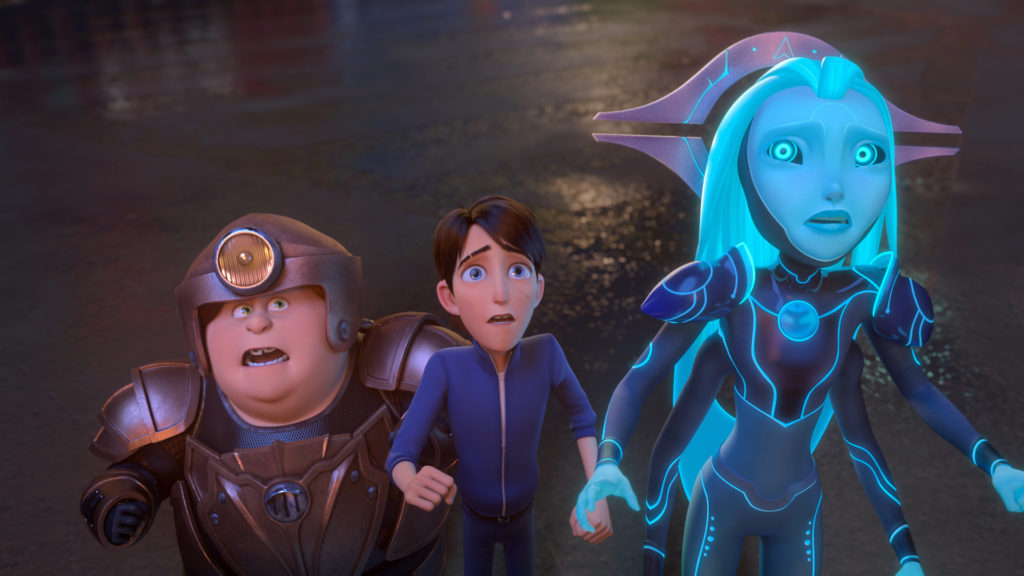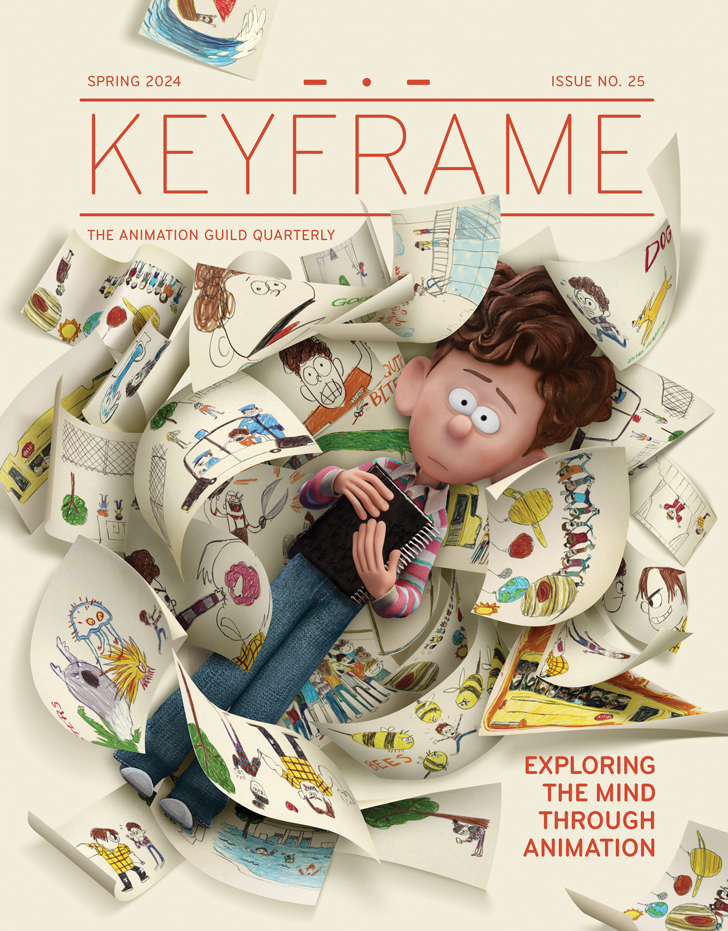Typically, a grand finale evokes visions of a mind-blowing, climactic scene. Filmmaker Guillermo del Toro is anything but typical. The conclusion of his episodic, three-series Tales of Arcadia takes an unconventional approach.
“We did originally consider extending the third series for a few episodes to bring the entire trilogy to a close,” says Executive Producer Marc Guggenheim, “but the scope and scale of the climax we were envisioning really demanded the larger canvas of a feature film.”
While this might sound like a big leap, it was actually an organic move, growing naturally out of a project that progressed over the years with the same main team of directors and storyboard artists. “Working for so long and so closely together, we learned our strengths and weaknesses, so we could manage ourselves in a way where we balanced each other out,” says Yingjue Linda Chen, who advanced from texture artist to visual development artist to her final role of art director on the third series and the movie. “I also think we ourselves as artists vastly improved throughout that time. So all of our knowledge from [all three series] was put into the movie, and that’s what I really love about it.”
First conceived as a live-action film and then an animated feature, Trollhunters eventually evolved into a TV show, and from the beginning, del Toro had a plan for three distinct series. Trollhunters (2016, 52 episodes), would be about a teen named Jim, in the suburban town of Arcadia Oaks, who is chosen to be the first human Trollhunter. 3 Below (2018, 26 episodes), was conceived as a tale of royal alien siblings who escape their planet and crash land in Arcadia. And Wizards (2020, 10 episodes), would follow a secret apprentice to Merlin whose job is twofold: recruit the Guardians of Arcadia and take them back in time to Camelot and confront the Arcane Order that wants to destroy humanity.
Complex? Yes. But del Toro “made this whole thing step by step for us,” says Alfonso Blaas, whose journey from the first series to the movie began as a visual development artist, expanding into art director and then production designer on Wizards and the movie. Still, he says, things could get tricky. “When you are finishing Trollhunters, you are in the middle of 3 Below, and you are starting to think about Wizards. That critical moment, even more than the movie—three shows running at the same time—that was the most intense in terms of learning.”
It was also intense because of the need to keep each elaborate world distinct. “For Trollhunters, the dichotomy between the troll world and the human world was the focus,” says Chen. “So establishing those two worlds to make sure that there was a contrast between them was really important. Then with 3 Below, because aliens were the lead characters, we tried to switch gears and do that new world justice. Guillermo was very adamant [about] seeing aliens that have no interloping design sense with the trolls. He wanted it to look special and unique.”
The team worked hard to stay true to each world’s aesthetic while making the series feel united. Numerous inspirations helped, from del Toro’s own live-action films to movies like E.T. and Star Wars that combined intimate and epic vibes. “With every show, we knew that we wanted to keep that kind of story, that kind of humor, that kind of adventure,” says Francisco Ruiz-Velasco, who started as a vis-dev artist when Trollhunters was being developed as a film, then returned as an art director and director for 3 Below and a director for Wizards and the movie. “I think that helped thread the three shows so they feel coherent, similar but different.”

The characters were also a key to continuity. Chen remembers an early meeting where del Toro said that “the relations between the characters are what weaves the entire story together. It can’t just be massive movements and giant fights and lots of fire. There has to be an underlying relationship story there to make the series resonate. That was the focus for him from the very beginning.”
Free Rein
With del Toro’s background as a strong visual director and most of the core team coming from film, they were used to feature techniques like lighting keyframes. “Most [animated] TV shows don’t use that,” says Ruiz-Velasco. “They just do a basic lighting for the whole show, and every [episode] looks the same. We wanted to have that more cinematic look, so we started doing color scripts [from the beginning]. It wasn’t planned, but we wanted to push it.”
“We just designed with no limitations… and then tried to make smart decisions on how to keep the massive feeling of the world, the massive feeling of the lore behind the show.”—Yingjue Linda Chen, Art Director
Blaas recalls creating these keyframes, trying to figure out colors, lighting scenarios, and shape languages for the epic world del Toro had created within the time and economic restraints of a TV series. He and the rest of the team pushed the bar, figuring out what worked and what didn’t, and by the second series they had improved the production pipeline to fit the show’s unique needs, establishing a dialogue to make things more efficient and figuring out how to get more out of the budget. “We were always trying to take the knowledge we learned from the first series and use it for the next and improve upon it,” says Chen. “I really do feel like that was one of the aspects where we were the most successful.”
This continual growth allowed for significant improvements in the third series, including pushing camera setup shots, color correction and color processing, and more sophisticated lighting to enhance cinematic effects. The latter was also aided by advancements in technology. “In 2014 [when Trollhunters was in production], it was hard to find cinematic lighting for TV,” says Blaas. “It was incredibly insane because you needed to design lighting for each of the scenarios.”
Fortunately, del Toro encouraged creative freedom to find solutions. “We just designed with no limitations,” says Chen, “and then tried to make smart decisions on how to keep the massive feeling of the world, the massive feeling of the lore behind the show.”

Crossing Over
“We always had high ambitions for the series,” says Chen, “but I do feel like with the movie we were able to realize more of those ambitions.”
With the constraints of creating for a TV series lifted, it was possible to make huge improvements to aspects like texturing and surfacing. “We could have sub-surface scattering on skin, for example,” says Chen, and Ruiz-Velasco adds, “the render technology was becoming so great that we could render stuff in real time and it looks top-notch.” Then there was the lighting. Along with Global Illumination when lighting scenes, “Alfonso was always an amazing painter,” says Chen, “but I think he pushed himself and really got into what lighting can do for the emotional beats of a movie.”
Another exciting opportunity was to see crucial scenes in real life. The team was able to utilize motion capture technology in the early phases of the production. This allowed them to play around with the movie’s monsters—Fire Titan, Ice Titan, and Earth Titan—in various settings and aided in the scenes where the main characters go up against the Arcane Order. Chen says that del Toro loves to play with scale, and this process gave visual development a deeper sense of the massive scale the battle scenes required. “They fight and we see movement,” says Blaas. “We see the cameras and how much set extension we need.”

At the same time, says Chen, “Because we had to use the Titans for so many shots … we built several different versions for the mid-shot, for the far shot, and for really close-up because, if you take the high-res one and you try to do wide shots with it … we’re not going to see the detail.” That detail was important for enabling contrasts that emphasized the colossal scale.
As for the movie’s plot, it’s equally ambitious, bringing together disparate characters from all three series’ worlds to prevent the Arcane Order from ending humanity. Fortunately, production had already tested the concept in a crossover episode in 3 Below. “It felt good. It felt right,” says Chen. Then came the movie, and “we had made these characters, and we loved them and believed in them. We didn’t agonize over how to bring them together. We just did it. And I felt like all of our knowledge, and especially working together and improving our own art, it shows in the final product … Experience really does count.”













.png)